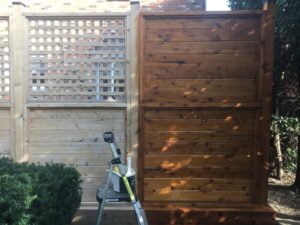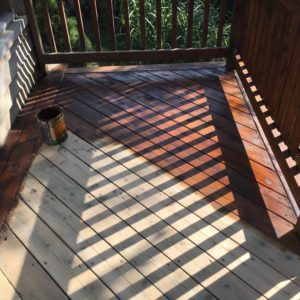Let’s be honest: the weather in southern Ontario is not very friendly to our decks, gazebos & exterior wood in general. We have cold winters with extended periods below freezing, a decent amount of snow that sits on the decks all winter, yo-yo spring weather that can be shorts & tees one day, snow flurries the next & finally, hot summers that rival what you see in places like South Carolina on a bad day. Wood is like your skin & it doesn’t like being exposed to these elements without protection. So what can you do?
There are generally three options available to you: 1) let the wood weather naturally, 2) paint your wood & 3) prepare and stain your wood. Let’s go through the options:
- Let the wood weather naturally. There is really only one positive to this option is that you do not need to do maintenance on it. All Hail Neglect! You get the oil changed on your car, you put weather stripping around your windows and you try to take care of your health. Your exterior wood needs TLC as well. Wood will crack & rot which can be both dangerous and a waste of money. Take some time to protect that deck & fence or you may as well just throw your money away because that deck & fence will not last.
- Paint your wood. Painting your wood will provide a protective surface coating for your wood. There are just a few issues with painting. Right off the bat, paint forces you to have a solid finish that will not show the natural grain of the wood. Second, if you are doing a deck, you will need to paint all six sides of the board as the paint is not nearly as breathable as a solid stain. Ground moisture can come through the wood & peel the paint off the deck. Third, not all paints are 2 in 1 paint & primers so you may need to prime the wood and in the case of a redwood, prime with an oil-based primer to seal in the tannins. Otherwise, you will have red spotting that seeps through the finish.
- Prepare & stain your wood. I’ll lay my cards on the table right now: this option takes the most work, it isn’t easy work and I make a living because most people will not commit to doing the needed level of work themselves. BUT… the rewards are SO SO WORTH IT! There are 3 steps to doing a deck right: washing, sanding & staining. If the deck is new or relatively new (two years or less), I usually can get the deck clean with a clear water power wash. If needed, I do not hesitate to get a cleaner out & there are several good ones on the market. When power washing, I recommend using an electric unit as they have less power than gas & the gas units are prone to damaging the wood fibres. We want the wood clean, not pummeled into submission. Not that the wood is clean and dry (generally 3 dry days so that you don’t ruin the wood by over sanding it while damp), it is time to do the sanding. I use a large floor sander unit that you can rent from any home improvement retailer. Depending on the condition of the deck, I generally sand 2X. My first sanding is with a 36 or 50 grit sandpaper to really get the old wood fibres off the top layer and open up the wood to absorb the stain. My second sand is usually a 100 or 120 grit to get a smoother surface for appearances & and to be more comfortable underfoot on a deck. If you use too fine of a grit, you basically polish the wood and make it hard for the stain to penetrate into the wood. Finally, time to hit the payday: staining. I am a hardcore Sico Proluxe (formerly Sikkens) guy who loves their VOC- compliant Cetol translucent finishes. You’ll need to pry the Cetol from my cold, dead hands to give it up. On decks, I use Cetol SRD which is an one coat, matte finish designed for horizontal surfaces. It is breathable so it doesn’t peel and it comes in some amazing looking woodtones. With one coat coverage & breathability, it won’t peel & the recoat process down the road is a breeze. For gazebos, siding & garage doors that require a glossier finish, I recommend the Cetol 1 & 23 system. This system results in a satin finish that will draw Owws & Awws from the neighbours. It involves one coat of Cetol 1 as the base coat & two coats of the Cetol 23 as the top coat. It provides a finish that looks like something out of a magazine. However, because it does build up to a hard finish, it isn’t breathable and is not suited for a deck.
So, if I haven’t already tipped you off to my preference, I’m an old school stained wood guy. Yes, it takes the most work but it also yields the most impressive results. If you have this wood on your property, why not make it stand out? Yes, it costs time & money but so does your car & you don’t neglect that, do you? After all, you wouldn’t buy a BMW and then shop for your tires at Walmart, would you?


